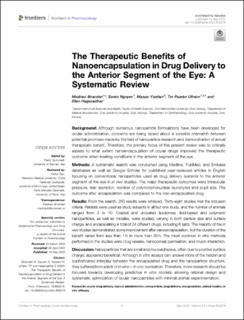The Therapeutic Benefits of Nanoencapsulation in Drug Delivery to the Anterior Segment of the Eye: A Systematic Review
Peer reviewed, Journal article
Published version
Permanent lenke
https://hdl.handle.net/11250/3057915Utgivelsesdato
2022Metadata
Vis full innførselSamlinger
Sammendrag
Background: Although numerous nanoparticle formulations have been developed for ocular administration, concerns are being raised about a possible mismatch between potential promises made by the field of nanoparticle research and demonstration of actual therapeutic benefit. Therefore, the primary focus of this present review was to critically assess to what extent nanoencapsulation of ocular drugs improved the therapeutic outcome when treating conditions in the anterior segment of the eye. Methods: A systematic search was conducted using Medline, PubMed, and Embase databases as well as Google Scholar for published peer-reviewed articles in English focusing on conventional nanoparticles used as drug delivery systems to the anterior segment of the eye in in vivo studies. The major therapeutic outcomes were intraocular pressure, tear secretion, number of polymorphonuclear leucocytes and pupil size. The outcome after encapsulation was compared to the non-encapsulated drug. Results: From the search, 250 results were retrieved. Thirty-eight studies met the inclusion criteria. Rabbits were used as study subjects in all but one study, and the number of animals ranged from 3 to 10. Coated and uncoated liposomes, lipid-based and polymeric nanoparticles, as well as micelles, were studied, varying in both particle size and surface charge, and encapsulating a total of 24 different drugs, including 6 salts. The majority of the in vivo studies demonstrated some improvement after nanoencapsulation, but the duration of the benefit varied from less than 1 h to more than 20 h. The most common in vitro methods performed in the studies were drug release, transcorneal permeation, and mucin interaction. Discussion: Nanoparticles that are small and mucoadhesive, often due to positive surface charge, appeared beneficial. Although in vitro assays can unravel more of the hidden and sophisticated interplay between the encapsulated drug and the nanoparticle structure, they suffered from a lack of in vitro—in vivo correlation. Therefore, more research should be focused towards developing predictive in vitro models, allowing rational design and systematic optimization of ocular nanoparticles with minimal animal experimentation.

